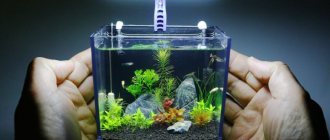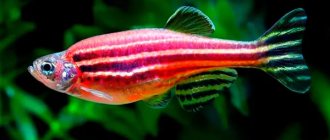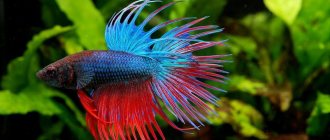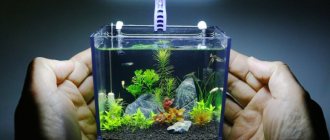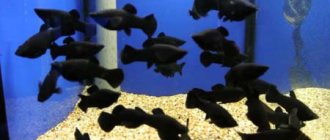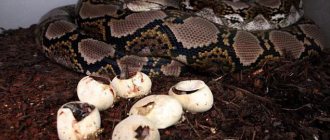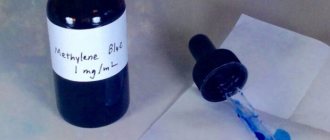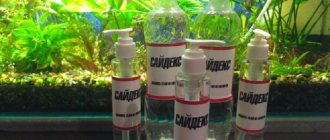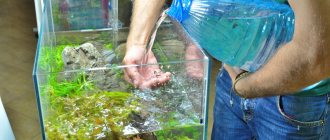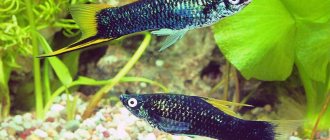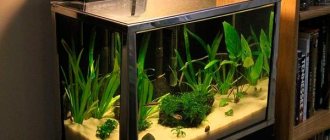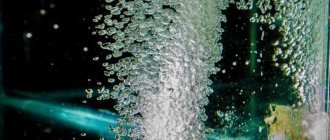Everyone has their own hobby. Some people love sports, some like to draw, and some are into aquarium farming. This type of activity helps to relax and unwind after a hard day or week; it is suitable for calm, peace-loving and friendly people.
But what kind of fish are worth considering? What types are there? What are the features? And what kind of care is needed? What aquarium fish are suitable for beginner aquarists?
General characteristics and phenomenon of viviparous fish
Livebearers attract most aquarists due to their ease of breeding. They do not require special spawning grounds, nurseries, temperature or light conditions for reproduction. Owners immediately receive ready-made fry in a common aquarium, capable of independent life.
It would be more correct to call such fish “ovoviviparous.” The fact is that before the fish are born, each fry is gestated inside the female in a separate egg and feeds on its contents. During the birth process, the walls of the eggs are destroyed, and the young hatch into the water column.
There are about 200 species of viviparous fish, some of which are bred and kept in aquariums. They include three families:
- four-eyed;
- Houdiaceae;
- Poeciliaceae.
A large number of viviparous fish lead a schooling lifestyle.
A large number of viviparous fish lead a schooling lifestyle
conclusions
Viviparous fish are considered the best first pets for beginning aquarists. These creatures are easy to care for and attract attention with their bright colors and behavior.
Livebearers are versatile and can live in both freshwater and marine aquariums. These features make viviparous fish an excellent choice for adding to an aquarium. With their help, each tank will become a source of beauty, and will allow you to enjoy the closeness of nature in your home.
Previous
FishSinging striped catfish Platydoras
Next
Fish Aquarium Ornatus: description of varieties
Other varieties
In addition to those listed, there are other types of viviparous fish.
Endler's guppy
The guppy's closest relative comes from Venezuela. However, endlers are much smaller in size, and the caudal fin is bicornuate. Gender differences are also clearly visible. The females of these guppies are inconspicuous, with silvery or golden scales, they grow up to 4 cm. The males are full of different colors, but they are inferior in size and grow only 2.5 cm. They do not live long - 2-3 years.
Endler's guppies do not live long - 2-3 years
For a school of 6 Endler fish, a 40-liter container equipped with a filter, an aerator, and dense vegetation shading the aquarium will be sufficient. Endler's guppies cannot tolerate bright light.
Brachyraphis rosena
A very nimble livebearer from the poeciliaceae family, with a bright, variegated color, native to the reservoirs of Costa Rica and Panama. It has medium sizes (girls – 6 cm, boys – 4 cm). Lifespan in captivity is 4 years. For a flock of 5-6 individuals, a 50-liter aquarium is suitable, which must be equipped with a large number of shelters.
The fish is nimble and not very peaceful even towards its relatives - brachyraphis will not give rest to a pregnant female, and can also eat the entire brood of fry.
The fish is nimble and not very peaceful even towards its relatives
Breeders are required to resettle a pregnant female and return it to the public body only after giving birth.
Alfaro
The livebearer is a medium-sized animal with an almond-shaped body and a sea green color. Small scales on the back are a darker shade than on the abdomen. It reaches a length of 8-10 cm; in aquarium conditions it lives up to 3 years. Friendly towards fry.
Alfaros live up to 3 years in aquarium conditions
Belonesox
Large-sized predatory viviparous. The body length of the female reaches 20 cm, and in males -12 cm. Belonesox resembles a pike in a reduced size, has the same narrow elongated body with a long muzzle and large eyes. The color is bronze-green with a black spot on the tail. They live no more than 3 years.
These predators behave aggressively not only towards young animals, but also during spawning, female representatives hunt males: they chase them, bite them and can even sit down. To avoid this, during the mating season you should feed whitenesoks well. Tadpoles, bloodworms, worms, and tiny fish are suitable as food.
Belonesox resembles a pike in a reduced size
Golomyanka
A very unusual livebearer, not related to aquariums. It inhabits the deep waters of Lake Baikal (feels great at a depth of 100 m). This creature is 25 cm long without scales, it has “naked” pale pink skin, a large mouth and large dark eyes. The swim bladder is missing.
After giving birth, the female golomyanka dies, and the fry are eaten by their relatives. Breeding in an aquarium is extremely difficult.
Golomyanka is a very unusual livebearer, not related to aquariums.
Gambusia
This inconspicuous fish has won love all over the world thanks to its ability to eat the larvae of malaria mosquitoes. Thanks to this “savior,” it was possible to stop the malaria epidemic, the most dangerous disease for humans.
Its homeland is the Missouri River. The fish itself looks like a guppy, but its color is faded and inconspicuous - a gray-green body and translucent fins. Females grow up to 7 cm, males - only up to 4.5 cm. The fish is not very friendly, it likes to play around with the fins of its neighbors. It is better to populate the aquarium with a flock of 6 individuals, one of which should be male.
Gambusia is not very friendly, it likes to play with the fins of its neighbors
Ghirardinus
Small livebearers are native to South America, preferring swampy, stagnant bodies of water. The size of girls does not exceed 6 cm, they look massive compared to boys, who rarely grow to 3 cm and have a more fragile, graceful physique. Color ranges from lemon yellow to gray-silver with black dots throughout the body.
The fish can live in a densely populated body of water. For one specimen, 2 liters of high-hardness water is enough; the temperature can range from 15 to 24 degrees.
For one Gigardinus, 2 liters of high-hardness water is enough
The animal is very peaceful and will get along with any neighbors of a similar character and size.
Iliodon Xanthus
The medium-sized livebearer comes from Mexico, has an elongated body 10-12 cm long, olive tint and a yellowish abdomen. An interesting feature of the phenotype is the dorsal fin located closer to the tail rather than in the middle
Iliodons are aggressive, and it is better to keep them in a well-aerated species aquarium with 4-5 liters per individual at a temperature of 22-26 degrees.
Iliodons are aggressive and are best kept in a well-aerated aquarium.
During pregnancy, the female is connected to the fry by an umbilical cord, so her nutrition must be enhanced and balanced.
Platipecilia
Platipecilia, or spotted platypecilia, has different shades of scales: gray-blue, with an olive tint, orange, but a characteristic feature of all morphs is the presence of dark specks on the body.
Small males (3-4 cm) and twice as large females (6-7 cm) are extremely unpretentious. They can live in crowded conditions (1.5-2 liters per specimen), withstand a wide range of temperatures, feed on all types of food, reproduce quickly and get along with any neighbors of a similar nature and size.
Platipecilia can withstand a wide range of temperatures
Limia black stripe
It belongs to the poeciliaceae family, so it is very similar to its relatives. The homeland is considered to be the island of Haiti and the shallow waters of the Caribbean. Female fish reach a length of 7 cm, while male fish look more fragile and miniature. A distinctive feature is vertical stripes on a silver-olive background of scales, the abdomen, tail and head are yellowish.
These creatures cannot stand loneliness and live only in groups. A lone specimen will certainly die.
It would be optimal to keep a flock of 6-7 individuals in a 70-80 liter container with bright lighting and a temperature of 25-28 degrees.
It would be optimal to keep a flock of 6-7 individuals in a 70-80 liter container
Formosa
A very useful livebearer that helps clean the walls of the aquarium and decorations from plaque. This tiny creature (1.5-3.5 cm in length) feeds on lower algae, as well as microorganisms that clog its aquatic habitat.
Originally from Southeast Asia, it prefers temperatures of 20-26 degrees. It has an unusual appearance - an elongated body of silver-sand color with reddish fins located in the tail, and a strongly elongated lower jaw for capturing food from the surface of the reservoir.
Formosa helps clean aquarium walls and decorations from plaque
These little ones are kept in a well-lit species aquarium in a flock of 10-12 individuals, because due to their size, they can become prey for larger neighbors. The Formosan fish themselves are also not averse to having fun with the veiled fins of their cohabitants.
Priapella
The beautiful Priapella is a peaceful aquatic creature with golden scales and heavenly-colored eyes. The blue-eye grows no more than 7 cm, females are slightly larger than males.
Inhabitants of the same temperament are added to the priapel as neighbors. In this case, one should take into account the timid nature of beauties, who can jump out of the home even if the light is turned on. The container should always be covered with a lid.
Beauty Priapella - a peaceful aquatic creature with golden scales
Houdiaceae
The phenotype received its name in honor of the famous ichthyologist D. Goode. These creatures are a transitional link between spawning fish and viviparous fish. The habitat is concentrated in Mexican mountain rivers. Therefore, at home, these creatures should be kept in a clean and well-aerated dwelling with a volume of at least 50 liters.
They have a tall body strongly compressed on the sides, the average life expectancy is 3-4 years. Males are outwardly brighter and more expressive than females, but they are smaller in size.
The average lifespan of these fish is 3-4 years
Sail mollies
A large representative of ray-finned fish of the poeciliaceae family, reaching a length of 15-17 cm. It prefers to live in the well-warmed brackish waters of the Yutakan Peninsula.
The abdomen of the sail-shaped molly (another name is the Velifera molly) is golden in color, and the rest of the body is silver with iridescent pearlescent spots. On the back of the velifera there is a high fin consisting of 20 rays. During mating games, males “fluff” it to attract a female.
A large representative of ray-finned fish, reaching a length of 15-17 cm. An oblong-shaped container with a large amount of vegetation necessary for males will be optimal for keeping. The more plant foods in their diet, the higher the dorsal fin. The water should be warm (27 degrees), clean and enriched with oxygen.
Cyprinodontiformes
This is a order of freshwater ray-finned fish, which includes 1257 species living in the tropical and equatorial waters of Asia, Africa, and America. Most representatives have a bright, colorful color.
The order received its name for its resemblance to the carp family. However, the main difference is the presence of carp-shaped teeth in the oral cavity, which are completely absent in cyprinids.
Most carp-toothed fish have a bright, colorful color
Dermogenis (Half-snout fighting)
Dermogenis dwarf is a viviparous species native to Southeast Asia. It got its name because of the unusual anatomy of the jaws: the lower one is half as long as the upper one, and there is a hook at the end. This structure allows dermogenis to capture food from the surface of the water surface.
The body of the semi-snout is highly elongated. The color ranges from grayish-silver to blue. The size of dermogenis reaches 8 cm, females are larger. The main distinguishing sexual characteristic is the color of the dorsal and anal fins. In boys they are purple-red, in girls they are less bright and yellowish.
Males are very aggressive, so it is optimal to keep them in species aquariums with a volume of 50 liters for 8 specimens, two of which are male. In the home environment they live up to 5 years.
In nature, they prefer stagnant and slow-flowing bodies of water and can withstand temperatures ranging from 22 to 32 degrees.
Dermogenis live up to 5 years in a home environment
Mollies Sphenops
This species gained its popularity due to its matte black color. It is quite active and peaceful. Like Swordtails, they are good jumpers, so a cover is definitely necessary.
The female reaches a size of 8-10 cm, the male up to 6 cm.
Parameters for a comfortable existence:
- temperature from +24-27° C;
- acidity from 7-8 pH;
- hardness from 10-20° dH.
How to choose and is it suitable for beginners
Livebearers are a great start for new aquarists. Most of them are completely undemanding. For example, guppies, gerardinus, and platies can live without aeration, filtration, hardness control and lighting. At the same time, the breeding process is significantly simplified - there is no need to create special conditions for eggs to ripen and worry that the entire offspring will die from minor fluctuations in water parameters. Embryos develop in ideal conditions - in the mother's abdomen.
When choosing your first pets, you must follow the general selection rules:
- carefully examine the animal's body, there should be no ulcers, damage, white spots, bitten or frayed fins. The scales should be shiny and smooth;
- observe its behavior; if the fish exhibits behavior unusual for its temperament, most likely such a specimen is sick and you should refuse to purchase it;
- comply with the required population density in water housing;
- select pets with identical character and lifestyle.
Select pets with identical character and lifestyle
By following the basic rules for selecting aquarium inhabitants, the owner will be able to create ideal conditions for their living and reproduction.
Mollies Sailfish
Popular among aquarists because of its unusual fin, which looks like a sail. The size of the female is from 16-20 cm. The size of the male is from 10-15 cm. Due to such large sizes, the minimum volume of the aquarium should be 100 liters.
Parameters for a comfortable existence:
- temperature from +24-27° C;
- acidity from 7-8.5 pH;
- hardness from 13-20° dH.
It is not advisable to house with Sumatran Barbs, because they can tear off the fins of Mollies.
It is unpretentious in food, but loves mosquito larvae, so you can give live food more often.
Features of care
Caring for viviparous fish is not difficult, since all phenotypes have good adaptation to new conditions and can safely withstand temperature changes, moderate lighting, lack of oxygen, and increased water hardness. However, such conditions do not have to be constant; filtration and aeration should still be present to avoid illness in pets and to reduce the frequency of manual cleaning.
The tank capacity is selected at 1.5-5 liters for each specimen. The water temperature varies from 20 to 29 °C, and is changed weekly. At night, the aquarium is shaded.
For the comfort of the pets, you should place a couple of shelters in the tank, and also plant living vegetation so that the viviparous female has a rest from male attention, and the fry have the opportunity to hide from the voracious adult cohabitants.
Caring for fish is not difficult, as they adapt well to new conditions.
The viviparous diet consists mainly of plant foods and is supplemented with live, frozen food and pellets. You can also feed your pets with chopped vegetables, scalding them with boiling water in advance. Adults are fed once a day, and babies - four times a day.
sword bearer
Swordtails lead a group lifestyle, so for their comfortable existence it is necessary to purchase 7-9 individuals. It should be remembered that there must be at least 2 females per male. They grow up to 10 cm, so they cannot be kept in a small aquarium. The minimum volume for a comfortable existence is 10 liters per individual.
The interesting thing is that they are quite good jumpers and if one day you don’t want to find your pet on the floor, then you must definitely purchase a cover.
The best habitat for Swordtails is natural shelters. Algae, driftwood, stones - all this can be used in arranging an aquarium.
Loves clean and oxygenated water, so take care of a good and high-quality filter and compressor. The light should not be sharp and bright, but diffused, because Swordbearers are quite shy and afraid of harsh light. Add floating seaweed with wide leaves to create shade. Pebbles or sand can be used as soil.
Parameters for a comfortable existence:
- temperature from +20-28° C;
- acidity from 7-8 pH;
- hardness from 9-25° dH.
Good neighbors: Molinesia, Pecilia, Ancistrus catfish, Corydoras, Minors, Tetras.
Do not house with: Astronotuses, Acaras, Cichlazomas, Cockerels.
They are not picky about their diet; they can be fed with dry, live or frozen food.
General breeding rules
Ovoviviparous creatures are extremely fertile, and the process of breeding them is incredibly simple. During one spawning, one mother can give birth to about 200 viable fry. It should be remembered that for every 1 male there should be 2-3 females.
Livebearers reach maturity at 3-4 months. The birth of fry occurs as follows:
- In the female, eggs are born in the body.
- The male fertilizes the female with the help of seminal fluid and gonopodium.
- Within 25-50 days, the eggs mature and form inside the female.
- One fertilization is enough for several births. The mother gives birth to part of the babies, the remaining part continues to mature inside the female and is born after a while.
- After hatching, the babies swim to the surface of the water surface and fill their swim bladder with oxygen.
A dark spot near the anal fin, a rounded abdomen and aggressive behavior of the female will help you know that the pet is ready to reproduce.
Viviparous fish fry grow and develop quickly
To preserve the offspring, the young are raised either in a special nursery, or the home is densely planted with vegetation, in which the fry can hide from their voracious parents.
The young grow and develop quickly. Within 24 hours she is ready to eat crushed adult food.
Mollies
Mollies are quite popular aquarium inhabitants that are unpretentious. It is better to house them in a flock of 7 individuals (2 females per 1 male). It is better to choose natural decorations with the addition of driftwood where the fish will hide. It is necessary to add live plants.
Thanks to selection, a large number of subspecies have been bred; let’s consider the most popular:
How to distinguish a female from a male
All livebearers have well-defined sexual dimorphism. When selecting a flock of pets, it is easy to select the required number of different-sex individuals. The following main distinctive features are distinguished:
- girls are larger, more plump and more massive, boys are smaller and more graceful;
- the color of males is richer, brighter, more colorful, the fins are larger and fluffy, male specimens are much more attractive and beautiful;
- male individuals have a gonopodium - a reproductive tube-like process, with the help of which fertilization of eggs occurs;
- in males the shape of the anal fin is pointed, in girls it is rounded.
The color of the males is richer, brighter, the fins are larger and fluffy.
Based on these characteristics, a group with the correct ratio of males and females is selected.
Mollies Latipina
It has a bright color, which is why it is also popular among aquarium lovers. They grow up to 12 cm, so an aquarium of at least 100 liters is required.
Optimal water parameters:
Parameters for a comfortable existence:
- temperature from +24-27° C;
- acidity from 7-8 pH;
- hardness from 13-20° dH.
Compatibility with other fish
Most ovoviviparous fish are peaceful aquarium creatures that can get along with neighbors of similar size and temperament.
It is best if only livebearers of the same or different phenotypes of the same temperament live in one hydrobiont. However, if the owner wants to diversify his home pond, then barbs, gouramis, zebrafish, angelfish, cockerels, discus, neon, bots and labios can be added as neighbors to livebearers. These animals do not show aggression.
The proximity to carp, goldfish, astronotus, South American and African cichlids will be unfavorable.
Livebearers are ideal pets, especially suitable for beginners. These are unpretentious creatures that show resistance to the emergence of unfavorable conditions in a changing environment. Simple care, ease of feeding, variety of species and colors allow their owners to enjoy the aquarium while observing the habits of its inhabitants.
Have you kept viviparous fish in an aquarium? Share your opinions about these species in the comments.
Guppy
Guppy is a schooling fish, it needs to be kept at least 6 individuals (2 females for 1 male). For comfortable living, you need to keep from 1 liter per 1 individual. They can rightfully be called the most unpretentious in aquarium life. But despite the fact that many people think that no special conditions need to be created for them, these fish require strict maintenance rules.
You can choose any soil, but preferably soft, without sharp stones. The same requirement applies to jewelry. They love dense thickets of algae, so you need to make sure that they have somewhere to hide. But don’t fill the entire space with plants, leave room for free floating.
Parameters for a comfortable existence:
- temperature from +24-26° C;
- acidity from 6.5-7 pH;
- hardness from 10-25° dH.
Guppies are peaceful and can harm few people, but the opposite is often the case, so you should not house them with Rainbow Dash, Barbs, or Cichlids.
They are unpretentious in food, so you can feed them with dry, live and frozen food.
Xenotoka
Unpretentious in living conditions. An aquarium must be 50 liters or more. Unpretentious and adaptable to various conditions. The soil and plants can be anything. A standard filter will be sufficient.
Optimal water parameters:
- t(°С) — 15-30°С
- acidity - from 4 to 8
- hardness - from 10 to 25
The character of these fish is unpredictable. One flock can be absolutely harmless, while another can keep the entire aquarium in fear. They can behave aggressively towards fish with beautiful veil fins.
In nature it feeds on crustaceans and various larvae. In the aquarium it feeds on dry, live and frozen food.
Conditions for keeping viviparous fish in an aquarium
Almost all species of livebearers have natural immunity to changes in living conditions. Changes in water hardness, acidity, temperature shifts. However, it must be taken into account that frequent and prolonged exposure to extreme conditions reduces the viability of fish.
If we talk about the average conditions for keeping viviparous aquarium fish, then we can adhere to the following indicators:
- Water temperature is from 22 to 27°C.
- Acidity Ph 6.0 - 7.5.
- Hardness dH 7 -15°.
However, more comfortable living conditions will be discussed for each species separately.
As for arranging an aquarium, the rules are simple.
All popular viviparous fish lead a schooling lifestyle. For this reason, it is not recommended to use a small aquarium for keeping them. It is advisable that there be at least three liters of water per fish.
A prerequisite is the presence of areas with dense vegetation reaching the surface of the water. This is necessary not only for the adult fish themselves. The newly born young must hide for the first time so as not to be eaten. Also, among the thickets, the fry find a lot of “tasty” things. Among the plants, we can recommend the species of gyrophyll, cabomba, and limnophylla. However, fish cannot be limited to free swimming space.
It is also necessary to provide aeration and filtration of water in the aquarium. Good lighting is not contraindicated.
Although they periodically claim that viviparous aquarium fish are not demanding in terms of living conditions, however, this is not always the case. Temperature fluctuations during the period can directly affect the reproduction process. For example, the birth of dead fry in mollies. So, you need to try to avoid stressful situations for the fish.
Now let's move directly to the list of the most popular viviparous fish for the aquarium.
General breeding rules
Preparatory work begins with the selection of a female and a male, the fish are placed in a spawning tank for livebearers.
At the pet store you can purchase small aquariums that are attached to the inside of a community aquarium. If the volume of your aquatic tank allows you to install it, this is a good alternative to a free-standing spawning aquarium.
Then the mating games of adult individuals begin, the result of which is spawning. In females, the abdomen swells, on which a characteristic spot appears. Before labor begins, the male is removed from the aquarium. The duration of spawning depends on the type of fish.
Each individual species of viviparous aquarium fish has its own clear conditions for the course of pregnancy, its speed, the number of offspring, and the behavior of the parents.
After giving birth, it is best to separate the females from the fry. The offspring are fully formed and can independently feed on crushed food.
Pecilia
Pecilia likes to live in flocks, so it is better to place at least 6 individuals at once. Count on 10 liters needed for a pair of platies. It is necessary to provide water with good filtration. A lid is required for the aquarium, as the fish are quite jumpy. It is better to choose dark soil and add a lot of dense plants to the container, where Pecilia can hide. But remember that you must leave room for free swimming.
Parameters for a comfortable existence:
- temperature from +22-27° C;
- acidity from 7-8 pH;
- hardness from 15-20° dH.
This type of fish loves hard water, for which you can add marble chips to the soil.
Platies are very peaceful, so there should be no problems with the neighborhood. But large and aggressive fish, such as Astronotus, Acara, and Goldfish, are incompatible with Platies in the aquarium.
They are unpretentious in food, so they can be fed with any type of food.
Ameka
Ameka, despite its size (up to 9 cm), is quite aggressive. You need to house Amek from 6 individuals. For one male there are 2-3 females. The volume of the aquarium for a comfortable existence is from 80 liters. Lighting should be moderate without harsh light sources. A filter is required. Since a school of fish produces quite a lot of waste, it is necessary to replace up to 40% of the water with new water weekly.
Optimal water parameters:
- t(°С) — 25-28°С
- acidity - from 7 to 8
- hardness - from 9 to 19
Omnivores and unpretentious eaters. Both dry, live and frozen types of food can be used as food.
Belonesox
Belonesox and small in size (males up to 12 cm, females up to 20 cm), it is a formidable predator. In order to ensure a comfortable existence, you need an aquarium with a length of 100 cm and a volume of 200 liters. There should be a large amount of decor and vegetation from which the fish could hunt. The lighting is moderate; it is also recommended to add a level teaspoon of salt per 10 liters of water.
Optimal water parameters:
- t(°С) — 24-30°С
- acidity - from 7 to 8.5
- hardness - from 12 to 25
Belonesox's diet consists exclusively of live food. It is desirable to feed in the form of small fish capable of rapid reproduction, for example, Guppies. Feeding with larvae and worms is also an option. Feeding must be done at intervals of one day. The main thing is to keep an eye on the prey; if it is alive, it means the fish is not hungry.
